Lecture 1 - What is Culture and How to Study it (Book chapters 1 & 4)
0.0(0)
0.0(0)
Card Sorting
1/94
Earn XP
Description and Tags
Study Analytics
Name | Mastery | Learn | Test | Matching | Spaced |
|---|
No study sessions yet.
95 Terms
1
New cards
Culture definition (Heine)
Any kind of information that is acquired from other members of one's species through social learning that is capable of affecting an individual's behaviors
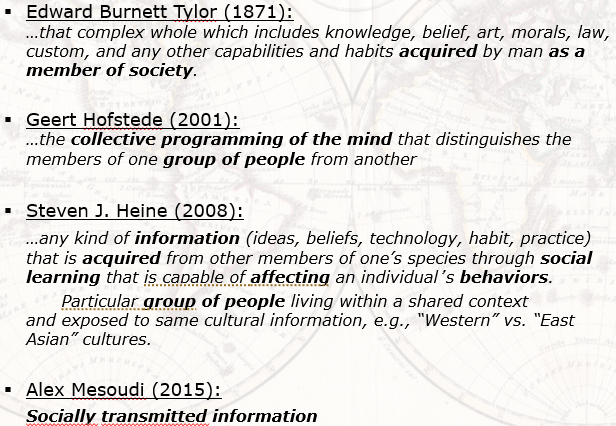
2
New cards
All cultural definitions agree that:
Culture is:
Learned (not inherited);
Shared (an attribute of groups);
Symbolic (relies on symbols e.g., language)
Learned (not inherited);
Shared (an attribute of groups);
Symbolic (relies on symbols e.g., language)
3
New cards
Iceberg of culture
Explicit/overt aspects (observable actions, artifacts, institutions)
Implicit/covert aspects (non-observable thoughts, beliefs, meanings, rules, norms, expectations)
Implicit/covert aspects (non-observable thoughts, beliefs, meanings, rules, norms, expectations)
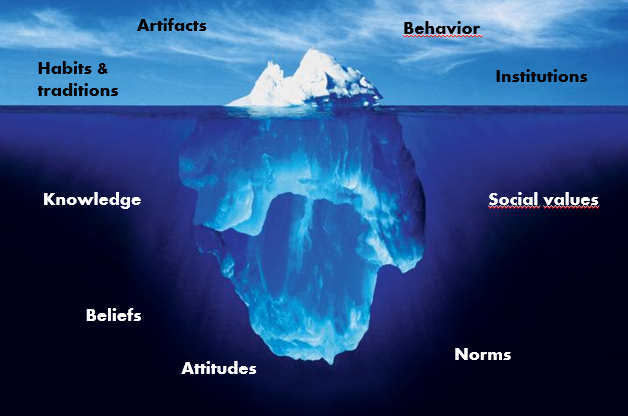
4
New cards
Culture is not
Only cultural values (complex interplay of societal factors and pervasive ideas);
Same as nation (cultural groups may be smaller than national borders);
Homogeneous/invariant within group (individuals embrace, react against, or ignore certain cultural messages depending on personal experiences and personality --> subcultures);
Stable over time
Same as nation (cultural groups may be smaller than national borders);
Homogeneous/invariant within group (individuals embrace, react against, or ignore certain cultural messages depending on personal experiences and personality --> subcultures);
Stable over time
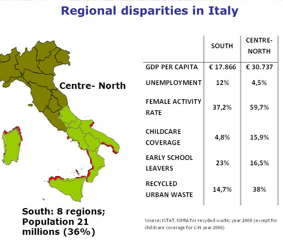
5
New cards
Instability of cultural values (X and Y-axis terms)
Survival values (low levels of trust/tolerance, emphasizes economic and physical security);
Self-expression values (high tolerance, democratic);
Traditional values (religion importance, parent-child ties);
Secular-rational values (less religion importance, divorce and abortion = more acceptable)
Self-expression values (high tolerance, democratic);
Traditional values (religion importance, parent-child ties);
Secular-rational values (less religion importance, divorce and abortion = more acceptable)
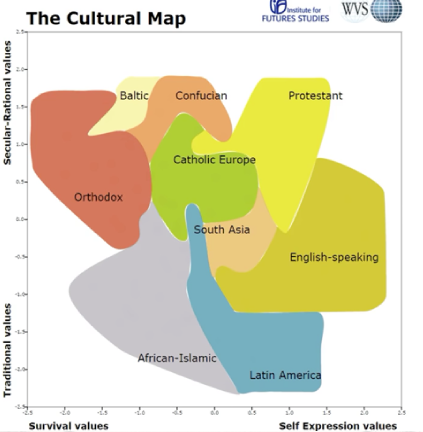
6
New cards
How unstable are cultural values?
Cultural values change but not extremely
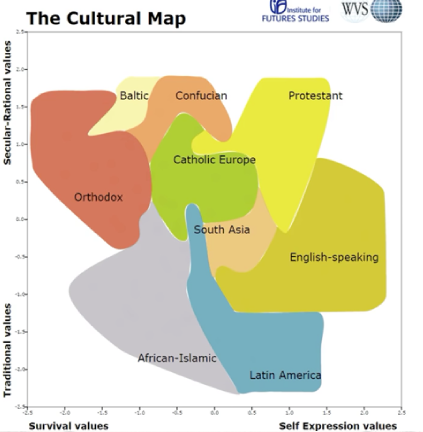
7
New cards
General psychology
Psychological processes = invariant/universal
Differences are superficial --> reflects noise
Mind and culture = independent
Differences are superficial --> reflects noise
Mind and culture = independent
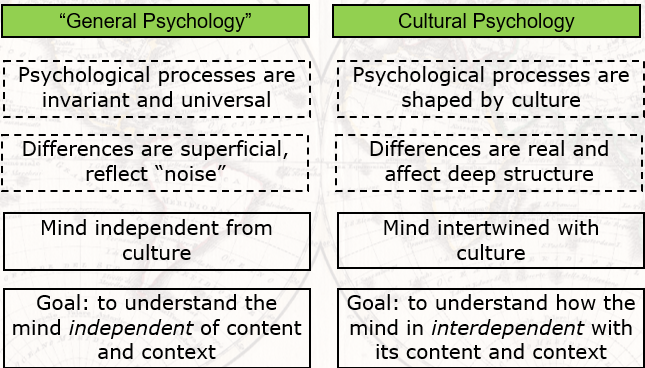
8
New cards
Goal of general psychology
To understand the mind independent of content and context
9
New cards
Cultural psychology
Psychological processes = shaped by culture
Differences are real and affect deep structure
Mind and culture = intertwined
Differences are real and affect deep structure
Mind and culture = intertwined
10
New cards
Goal of cultural psychology
To understand how the mind is interdependent with its content and context
11
New cards
Stimulus vs. absolute vs. relative task (line in square task)
Absolute task: required less concentration for European-Americans
Relative task: required less concentration for East Asians (because East Asians more likely to think about the world in terms of relative/collective position in society)
Relative task: required less concentration for East Asians (because East Asians more likely to think about the world in terms of relative/collective position in society)
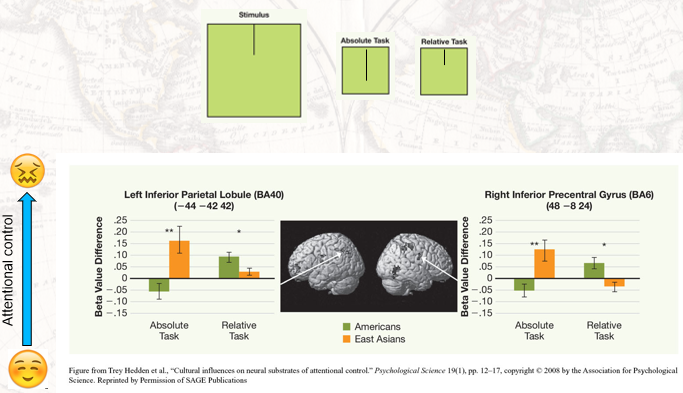
12
New cards
Müller-Lyer illusion (which line is longer?)
Line A and Line B are the same length
But some cultures may be more susceptible to thinking that B > A
But some cultures may be more susceptible to thinking that B > A
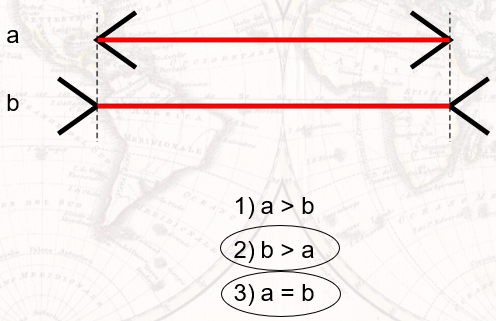
13
New cards
Susceptibility results (Müller-Lyer illusion)
American undergraduates more likely to be susceptible to this illusion
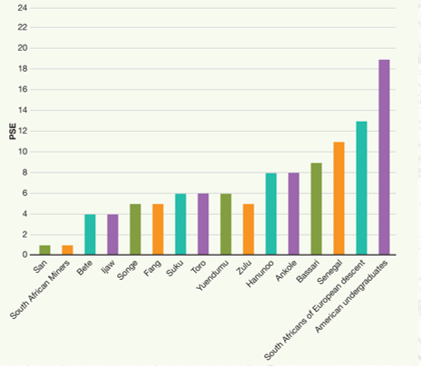
14
New cards
Why are American undergrads more likely to be susceptible to the Müller-Lyer illusion?
Americans more likely to see carpentered corners = provides info about relative distance
Non-westerners more likely to look at the arrow itself (not knowing that corners can be used as depth cues) vs. Americans looking at the corners for cues of relative distance
Non-westerners more likely to look at the arrow itself (not knowing that corners can be used as depth cues) vs. Americans looking at the corners for cues of relative distance

15
New cards
Levels of universality
Nonuniversal;
Existential universal;
Functional universal;
Accessibility universal
[NEFA]
Existential universal;
Functional universal;
Accessibility universal
[NEFA]
![Nonuniversal;
Existential universal;
Functional universal;
Accessibility universal
[NEFA]](https://knowt-user-attachments.s3.amazonaws.com/4df87be9ed014b28badbf36a9fb6da2c.jpeg)
16
New cards
Nonuniversal (cultural invention)
Cognitive tool not found in all cultures
E.g., abacus reasoning
E.g., abacus reasoning
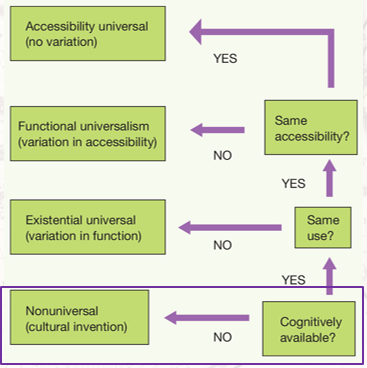
17
New cards
Existential universal (variation in function)
Cognitive tool found in all cultures that serves different function(s)
E.g., intrinsic motivation in the face of success or failure (different cultures get intrinsic motivation for different reasons)
E.g., intrinsic motivation in the face of success or failure (different cultures get intrinsic motivation for different reasons)
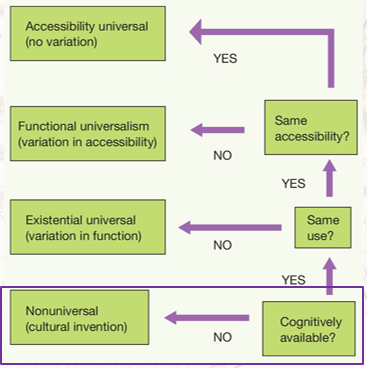
18
New cards
Functional universalism (variation in accessibility)
Cognitive tool found in all cultures that serves the same function(s)
E.g., costly punishments
E.g., costly punishments
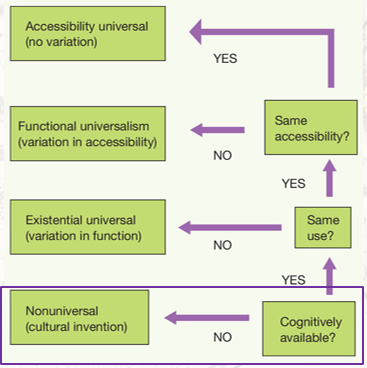
19
New cards
Accessibility universal
Cognitive tool found in all cultures that serves the same functions and is accessible to the same degree
E.g., social facilitation (finding that you do better work if you go to a library than if you stay at home to study)
E.g., social facilitation (finding that you do better work if you go to a library than if you stay at home to study)
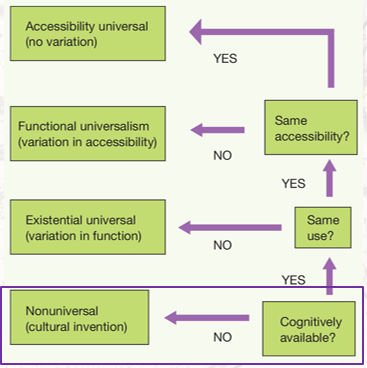
20
New cards
WEIRD samples
Western, Educated, Industrialized, Rich, Democratic

21
New cards
Generalizability
Do the findings generalize beyond the samples that were studied?
E.g., not always clear how well results from college students generalize to non-students
E.g., not always clear how well results from college students generalize to non-students
22
New cards
Power of a study
Capacity to detect an effect to the extent that such an effect really exists
Reflects quality of study design (e.g., can it identify the anticipated effect?)
Reflects quality of study design (e.g., can it identify the anticipated effect?)
23
New cards
Independent variable
Variable that is varied or manipulated
E.g., if researchers contrast two similar cultures, they would not have as much variance in their independent variable as if they had compared two very dissimilar cultures
E.g., if researchers contrast two similar cultures, they would not have as much variance in their independent variable as if they had compared two very dissimilar cultures
24
New cards
Dependent variable
Variable being measured
25
New cards
Culture-blind approach
When we think that we have addressed cultural differences and that we understand the differences. However, we do NOT understand the differences
26
New cards
Multicultural approach
Based upon democratic values and beliefs. It seeks to foster cultural pluralism within culturally diverse societies and an interdependent world
27
New cards
Ethnocentrism
Judging people from other cultures by the standards of one's own culture
(our culture causes us to be ethnocentric because we are socialized to value normative cultural behaviors)
E.g., thinking it is weird/incorrect to use chopsticks to eat
(our culture causes us to be ethnocentric because we are socialized to value normative cultural behaviors)
E.g., thinking it is weird/incorrect to use chopsticks to eat
28
New cards
How to study cultural variation
Culture --> [explanatory variable (e.g., cultural value)]
--> Behavior
Unpackaging culture: how people across cultures differ as well as in the many ways that people within a single culture deviate from the average
E.g., when trying to find a difference in how emotionally expressive Americans vs. Japanese are --> cultures differ in many aspects so there's many explanations --> which aspect of culture is responsible for this difference?
(once we're able to determine that aspect = unpackaged)
--> Behavior
Unpackaging culture: how people across cultures differ as well as in the many ways that people within a single culture deviate from the average
E.g., when trying to find a difference in how emotionally expressive Americans vs. Japanese are --> cultures differ in many aspects so there's many explanations --> which aspect of culture is responsible for this difference?
(once we're able to determine that aspect = unpackaged)
![Culture --> [explanatory variable (e.g., cultural value)]
--> Behavior
Unpackaging culture: how people across cultures differ as well as in the many ways that people within a single culture deviate from the average
E.g., when trying to find a difference in how emotionally expressive Americans vs. Japanese are --> cultures differ in many aspects so there's many explanations --> which aspect of culture is responsible for this difference?
(once we're able to determine that aspect = unpackaged)](https://knowt-user-attachments.s3.amazonaws.com/ff52349e90bb4ad6b505686ff38138ef.jpeg)
29
New cards
Occam's razor
The simplest solution to a problem tends to be the right one (theory should make as few assumptions as possible, eliminating anything extraneous)
E.g., a single explanation is more parsimonious, and more likely to be correct, than four separate ones
E.g., a single explanation is more parsimonious, and more likely to be correct, than four separate ones
30
New cards
Cultural values (definition)
Preferences for one state of affairs over another that distinguish countries (rather than individuals) from each other
31
New cards
Geert Hofstede's contributions
Individualism/Collectivism;
Power Distance;
Uncertainty Avoidance;
Masculinity/Femininity;
Long-term/Short-term orientation;
Indulgence/Restraint
Power Distance;
Uncertainty Avoidance;
Masculinity/Femininity;
Long-term/Short-term orientation;
Indulgence/Restraint
32
New cards
Michele Gelfand's contributions
Tightness/Looseness
33
New cards
What is individualism and what are examples of individualistic countries?
A belief in the importance of the individual and the virtue of self-reliance and personal independence
A society in which the ties between individuals are loose: a person is expected to look after himself or herself and his/her immediate family only
Highly individualistic countries: English speaking countries and Northwest Europe
A society in which the ties between individuals are loose: a person is expected to look after himself or herself and his/her immediate family only
Highly individualistic countries: English speaking countries and Northwest Europe
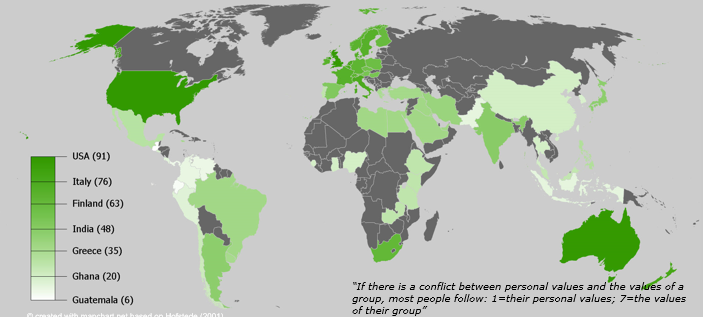
34
New cards
What is collectivism and what are examples of collectivistic countries?
A society in which people are integrated into strong, cohesive in-groups, which continue to protect them throughout their lifetime in exchange for unquestioning loyalty
Highly collectivistic countries: Latin America and Asia
Highly collectivistic countries: Latin America and Asia
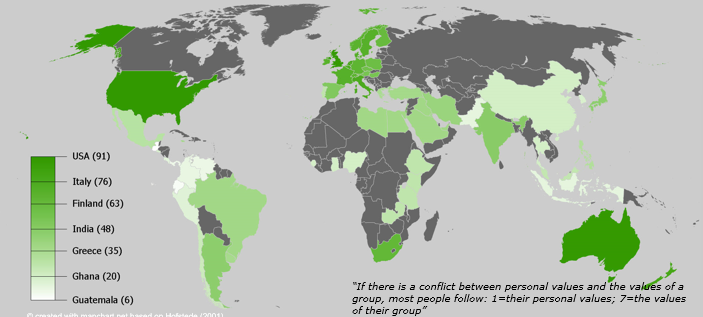
35
New cards
What is tightness, what are its correlates, and what are some examples?
Cultures have many strong norms and low tolerance of deviant behavior
Ecological correlates: population density, access to safe water, food deprivation
Societal correlates: retention of death penalty, police presence per capita, demonstration attendance
Psychological correlates: cautiousness, dutifulness, high need for structure
High tightness: Pakistan, Japan
Ecological correlates: population density, access to safe water, food deprivation
Societal correlates: retention of death penalty, police presence per capita, demonstration attendance
Psychological correlates: cautiousness, dutifulness, high need for structure
High tightness: Pakistan, Japan
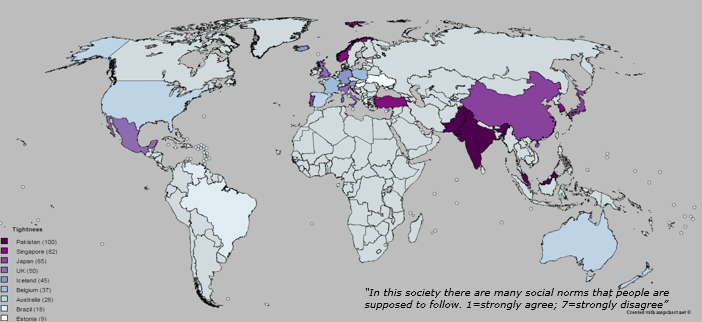
36
New cards
What is looseness and what are some examples?
Weak social norms and a high tolerance of deviant behavior
Low tightness (looseness): Eastern European countries, Brazil
Low tightness (looseness): Eastern European countries, Brazil
37
New cards
Caution when thinking about cultural values
Heterogeneity (difference) between and within cultures;
Cultural values/dimensions as continuum instead of exclusive categories (both ends exist in all cultures but one end tends to predominate);
None of the two ends is better than the other -- but one end may be more functional or historically prevalent than the other;
Other non-psychological factors involved (e.g., climate, affluence, etc.)
Cultural values/dimensions as continuum instead of exclusive categories (both ends exist in all cultures but one end tends to predominate);
None of the two ends is better than the other -- but one end may be more functional or historically prevalent than the other;
Other non-psychological factors involved (e.g., climate, affluence, etc.)
38
New cards
COSI concerns of cultural psych
Causation (how do I design my study and what conclusions can I draw?);
Operationalization (how do I measure my variables and how do I construct my material?);
Sampling (which cultures should I study?);
Interpretation (what does the data tell me?)
Operationalization (how do I measure my variables and how do I construct my material?);
Sampling (which cultures should I study?);
Interpretation (what does the data tell me?)
39
New cards
What is sampling and what does it test for?
Sampling of cultural groups (and participants within these groups)
1. Testing for universality
2. Testing for cultural variance
What cultural groups to study? How to select participants within these groups?
1. Testing for universality
2. Testing for cultural variance
What cultural groups to study? How to select participants within these groups?
40
New cards
Testing for Universality - sameness across cultures (sampling)
What cultures to choose?
Option 1:
Randomly select as many cultural contexts as possible
Option 2:
Select two maximally different cultural contexts in terms of language, geography, philosophical tradition, etc.
Option 1:
Randomly select as many cultural contexts as possible
Option 2:
Select two maximally different cultural contexts in terms of language, geography, philosophical tradition, etc.

41
New cards
Theory of Mind
The ability to attribute mental states to oneself and others and to understand that others have beliefs, desires, and intentions that are different from one's own
Comparison between American children and Baka children (illiterate hunter-gatherers with little exposure to Western ideas who live in the rainforests of Cameroon) = performed similarly on theory of mind test
Comparison between American children and Baka children (illiterate hunter-gatherers with little exposure to Western ideas who live in the rainforests of Cameroon) = performed similarly on theory of mind test
42
New cards
Testing for Cultural Variation - difference across cultures (sampling)
What cultures to choose? And if cultures differ, which cultural values explain these differences?
Option 1: Randomly select as many cultural contexts as possible
Option 2: "Just minimal difference" approach: match two cultural contexts in as many ways as possible (e.g., age, SES, gender, education), so that the only difference left is cultural value of interest (e.g., collectivism) e.g., China rice theory study
Option 1: Randomly select as many cultural contexts as possible
Option 2: "Just minimal difference" approach: match two cultural contexts in as many ways as possible (e.g., age, SES, gender, education), so that the only difference left is cultural value of interest (e.g., collectivism) e.g., China rice theory study
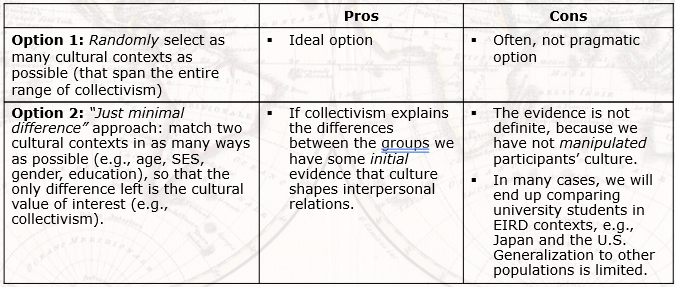
43
New cards
Operationalization w/ different types of equivalence (measure and manipulation of variables)
Make sure that study material = equivalent across cultural groups
Construct equivalence (similarity of construct across cultures -- e.g., construct bias occurs when construct measured is not identical across cultural groups: Chinese concept of “friend” refers to someone who is very close and relationship is expected to last long. Western concept of “friend” may include friends, close friends, acquaintances, long-time friends)
Methodological equivalence (making sure participants from different cultures understand research questions/situations in equivalent ways)
Linguistic equivalence (translation accuracy, retention of connotations)
Construct equivalence (similarity of construct across cultures -- e.g., construct bias occurs when construct measured is not identical across cultural groups: Chinese concept of “friend” refers to someone who is very close and relationship is expected to last long. Western concept of “friend” may include friends, close friends, acquaintances, long-time friends)
Methodological equivalence (making sure participants from different cultures understand research questions/situations in equivalent ways)
Linguistic equivalence (translation accuracy, retention of connotations)
44
New cards
Construct equivalence (scenario with consequence) (operationalizing)
Investigate happiness across different cultures: select 2 cultural groups and ask participants "how proud are you about your life achievements?"
BUT is the meaning/construct of happiness the same across cultures?
E.g., North Americans: derive happiness through personal achievements, maximize positive affect experiences
East Asians: derive happiness from interpersonal connectedness, balance experiences of positive and negative affect
Consequence: happiness measure is Western-focused and underestimates levels of happiness in East-Asian context (would be more East Asian-focused if: "how content are you with your relationships with others?")
BUT is the meaning/construct of happiness the same across cultures?
E.g., North Americans: derive happiness through personal achievements, maximize positive affect experiences
East Asians: derive happiness from interpersonal connectedness, balance experiences of positive and negative affect
Consequence: happiness measure is Western-focused and underestimates levels of happiness in East-Asian context (would be more East Asian-focused if: "how content are you with your relationships with others?")
45
New cards
Methodological equivalence (scenario) (operationalizing)
Compare IQ scores in India and UK --> shows the following photo --> but man not recognized as burglar in India
E.g., guy not recognized as a burglar in India because vertically opening windows are uncommon there
(to make meaningful comparisons across cultures, participants must understand questions/situations the same way. When cultures are not comparably familiar --> methodological equivalence more challenging)
E.g., guy not recognized as a burglar in India because vertically opening windows are uncommon there
(to make meaningful comparisons across cultures, participants must understand questions/situations the same way. When cultures are not comparably familiar --> methodological equivalence more challenging)

46
New cards
Linguistic equivalence w/ solutions to untranslatable words/cultural-specifics (e.g., boketto)
Back-translation (most common);
Bilingual collaborators (ideal);
Avoid very short/vague items (e.g., with non-translatable words)
Why would the Japanese invent a word to capture this state of mind?
- Buddhist tradition?
- Very crowded cities and over-stimulating environment = creates need for people to shut down and think of nothing
Bilingual collaborators (ideal);
Avoid very short/vague items (e.g., with non-translatable words)
Why would the Japanese invent a word to capture this state of mind?
- Buddhist tradition?
- Very crowded cities and over-stimulating environment = creates need for people to shut down and think of nothing
47
New cards
Back-translation
E.g., survey is in English
--> translated to Indonesian
--> one translator translates English into Indonesian while another translator translates Indonesian into English
--> compare results and discuss problematic translations
--> reach consensus on how to alter the material
--> translated to Indonesian
--> one translator translates English into Indonesian while another translator translates Indonesian into English
--> compare results and discuss problematic translations
--> reach consensus on how to alter the material
48
New cards
Response bias
Distorts accuracy of a person's response to survey questions
49
New cards
Socially desirable responding
People are motivated to be evaluated positively by others (as a result they might disguise their true feelings to appear more socially acceptable)
50
New cards
Types of bias interpretations
Moderacy and Extremity bias;
Acquiescence bias;
Reference-group effect
How do you know what people mean when they say something? How to interpret the way people respond to your questions/stimuli?
Acquiescence bias;
Reference-group effect
How do you know what people mean when they say something? How to interpret the way people respond to your questions/stimuli?
51
New cards
Moderacy bias
When people tend to choose the middle point of a likert-scale
Prevalent among East Asians > European (American)
Prevalent among East Asians > European (American)
52
New cards
Extremity bias
When people tend to choose the extreme ends of a likert-scale
Prevalent among Hispanic and African-American > European-American
Prevalent among Hispanic and African-American > European-American
53
New cards
Solutions to the Moderacy and Extremity biases
Avoid scales with middle response option, e.g., 1-6 (cons: does not address extremity);
Yes/no format (cons: reduced variance);
Standardize scores (cons: alters the data, only useful for comparisons of patterns e.g., anger vs. shame)
[AYS]
Yes/no format (cons: reduced variance);
Standardize scores (cons: alters the data, only useful for comparisons of patterns e.g., anger vs. shame)
[AYS]
54
New cards
Acquiescence bias
Tendency to agree with an item, regardless of content
Often present in cultures that have a holistic thinking style (East Asia), who see some truth in most statements -- behavior is more of a response to the situation rather than expression of one's character
Often present in cultures that have a holistic thinking style (East Asia), who see some truth in most statements -- behavior is more of a response to the situation rather than expression of one's character
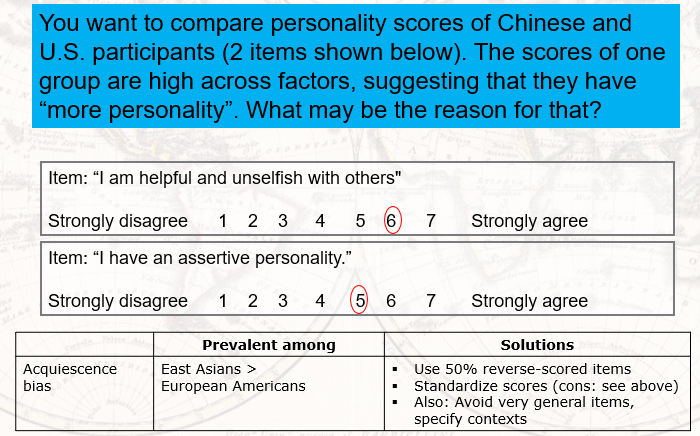
55
New cards
Solutions to the Acquiescence bias
Use 50% reverse-scored items;
Standardized scores (subtracting mean value of all scores in the set and dividing by set's standard deviation);
Avoid very general items and instead specify contexts
[USA]
Standardized scores (subtracting mean value of all scores in the set and dividing by set's standard deviation);
Avoid very general items and instead specify contexts
[USA]
56
New cards
Reference-group effect
Group to which the individual relates or aspires to relate themselves to psychologically (individual's frame of reference)
E.g., those who say they have higher academic abilities tend to perform better at school. However, students that perform best on international measures tend to rate their academic performance worse than those from the lowest-performing schools
(students compare themselves to either a higher or lower standard, depending on their school environment)
E.g., those who say they have higher academic abilities tend to perform better at school. However, students that perform best on international measures tend to rate their academic performance worse than those from the lowest-performing schools
(students compare themselves to either a higher or lower standard, depending on their school environment)
57
New cards
Solutions to the Reference-group effect
Use concrete scenarios (e.g., "If a friend of mine needed help with studying for their exam" instead of "I am helpful");
Use concrete response choices to a concrete scenario (e.g., NOT agree/disagree);
Avoid quantifiers (e.g., very);
Use behavioral or physiological measures (not self-reports)
[CSCCAB]
Use concrete response choices to a concrete scenario (e.g., NOT agree/disagree);
Avoid quantifiers (e.g., very);
Use behavioral or physiological measures (not self-reports)
[CSCCAB]
58
New cards
Deprivation effect
E.g., issue for measuring values across cultures where there is chronically less personal safety, people would express valuing it more
59
New cards
Between-groups manipulation
Different groups of participants receive different levels of the independent variable (Group A gets condition A | Group B gets condition B)
E.g., explore whether people are more persuaded by fast-talking salespeople or by slow-talking salespeople --> each participant randomly assigned to listen to either a fast-talking salesperson or a slow-talking salesperson --> measure all persuasion results and compare them
[AA-BB]
E.g., explore whether people are more persuaded by fast-talking salespeople or by slow-talking salespeople --> each participant randomly assigned to listen to either a fast-talking salesperson or a slow-talking salesperson --> measure all persuasion results and compare them
[AA-BB]
60
New cards
Within-groups manipulation
Each participant receives more than one level of the independent variable (Group A gets condition A and then B | Group B gets condition B and then A)
E.g., explore whether people are more persuaded by fast-talking salespeople or by slow-talking salespeople --> assess participant persuasion by a fast-talking salesperson and then by a slow-talking salesperson (vary order of salespeople between groups) --> all participants included in fast-talking and slow-talking conditions --> any differences in participant responses are due to the IV and not other factors
[AAB-BBA]
E.g., explore whether people are more persuaded by fast-talking salespeople or by slow-talking salespeople --> assess participant persuasion by a fast-talking salesperson and then by a slow-talking salesperson (vary order of salespeople between groups) --> all participants included in fast-talking and slow-talking conditions --> any differences in participant responses are due to the IV and not other factors
[AAB-BBA]
61
New cards
What is replication, and what are some reasons as to why a study does not successfully replicate?
Repeating a study and getting the same general pattern of results
Reasons a study might not successfully replicate:
1. Original finding not reliable
2. Replication effort had problems
Reasons a study might not successfully replicate:
1. Original finding not reliable
2. Replication effort had problems
62
New cards
Can culture be manipulated?
No and thus causal claims about cultural influence are limited (not possible or ethical to take children at birth and assign them to different cultural contexts)
However, there are different methods that allow to draw conclusions about interplay of culture and psychological processes
However, there are different methods that allow to draw conclusions about interplay of culture and psychological processes
63
New cards
Methods to draw conclusions about the interplay of culture and psychological processes
Survey;
Field experiment;
Neuroscience methods;
Situation sampling;
Cultural products;
Cultural priming
Field experiment;
Neuroscience methods;
Situation sampling;
Cultural products;
Cultural priming
64
New cards
Survey (pros)
Economic, easy to sample many participants;
Some equivalence issues can be solved by looking at patterns of means across groups (e.g., the prevalence of anger vs. shame in the US vs. Japan)
E.g., good when comparing multiple differences in relationships (e.g., examining how anger is caused by being insulted and not when people are being careless in one culture -- and that the reverse is true in the other culture)
Some equivalence issues can be solved by looking at patterns of means across groups (e.g., the prevalence of anger vs. shame in the US vs. Japan)
E.g., good when comparing multiple differences in relationships (e.g., examining how anger is caused by being insulted and not when people are being careless in one culture -- and that the reverse is true in the other culture)
65
New cards
Survey (cons)
Bias-prone because of self-report;
Without experimental manipulation, no causal claim is possible (purely correlational or descriptive results)
E.g., bad when comparing means on a single item (e.g., anger across cultures). Surveys don't allow causal claims unless IV has been manipulated (e.g., in cultural priming studies)
Without experimental manipulation, no causal claim is possible (purely correlational or descriptive results)
E.g., bad when comparing means on a single item (e.g., anger across cultures). Surveys don't allow causal claims unless IV has been manipulated (e.g., in cultural priming studies)
66
New cards
Field experiment (pros and cons)
Pros: high ecological validity (real-world vs. lab)
Cons: extraneous variables that cannot be controlled (e.g., weather, strikes)
Cons: extraneous variables that cannot be controlled (e.g., weather, strikes)
67
New cards
Culture of honor
People (mostly men) strive to protect their reputation through aggression and usually in places where law enforcement is limited -- having to take action into your own hands
68
New cards
Study on honor in North/South of the US (field experiment)
Mailing application letters w/ different descriptions of a convicted job applicant who committed a crime either out of honor or not (manipulation/IV) --> honor crimes received warmer letters of response (DV)
Suggests that honor crimes (e.g., going to prison for manslaughter because he had killed a man who slept with his girlfriend) are more respected
Suggests that honor crimes (e.g., going to prison for manslaughter because he had killed a man who slept with his girlfriend) are more respected
69
New cards
Agent-based modeling
A way of testing a hypothesis by creating simulations with virtual agents who are programmed to act autonomously in a computerized game
(e.g., honor response = stable strategy whenever environment is rugged and authorities are not available in resolving disputes)
(e.g., honor response = stable strategy whenever environment is rugged and authorities are not available in resolving disputes)
70
New cards
Neuroscience methods (pros and cons)
fMRI, EEG, research on genetic makeup across cultures
Pros: allows to draw conclusion about the biological bases of cultural variation
Cons:
expensive;
usually small samples (power issues);
emerging field -- not always clear what differences mean (e.g., one gene polymorphism)
Pros: allows to draw conclusion about the biological bases of cultural variation
Cons:
expensive;
usually small samples (power issues);
emerging field -- not always clear what differences mean (e.g., one gene polymorphism)
71
New cards
Study on brain activation during tasks in different cultural contexts (neuroscience experiment)
To test variation in genetic polymorphisms (e.g., dopamine D4 receptor as a proxy for susceptibility to cultural norms) explaining cultural differences in social orientation
72
New cards
Situation sampling (step 1 and 2) with situation/participation effect
The observation of individuals in several real-life situations as opposed to experimental situations (situations are generated by participants in more than one culture --> situations presented to different groups from multiple cultures)
Step 1: Participants from different cultures describe situations of a certain type (e.g., high self-esteem) --> large "situation sample"
Step 2: Participants from both cultures indicate how they respond to selection of situations from both cultures --> Situation effect OR Participant effect
Situation effect: Do situations common in one culture influence people differently than situations common in another culture
Participant effect: Do people in one culture respond differently to situations from another culture? (e.g., run a red light --> get traffic ticket --> less likely to disobey traffic lights OR some other response?)
Step 1: Participants from different cultures describe situations of a certain type (e.g., high self-esteem) --> large "situation sample"
Step 2: Participants from both cultures indicate how they respond to selection of situations from both cultures --> Situation effect OR Participant effect
Situation effect: Do situations common in one culture influence people differently than situations common in another culture
Participant effect: Do people in one culture respond differently to situations from another culture? (e.g., run a red light --> get traffic ticket --> less likely to disobey traffic lights OR some other response?)
73
New cards
Situation sampling (pros and cons)
Pros: sheds light on the process of how culture affects people psychologically --> causal inferences
Cons:
time-intensive multi-step research;
difficult to know what to leave in situation descriptions (i.e., what is necessary to understand them) and what to remove (i.e., cultural specifics)
Cons:
time-intensive multi-step research;
difficult to know what to leave in situation descriptions (i.e., what is necessary to understand them) and what to remove (i.e., cultural specifics)
74
New cards
Cultural products
Specify hypothesis --> Focus on most relevant products (e.g., architecture, performing arts, media) --> Code data (coders blind to hypothesis)
75
New cards
Cultural products (pros and cons)
Pros:
cultural products reflect the most prevalent cultural ideals/messages that members of a culture produce are exposed to;
data are already "available" -- only need to be coded
Cons:
mostly requires trained coders (time-and resource-intensive, subjectivity);
limited scope -- ideally supplemented with evidence for the effect of exposure to cultural products
cultural products reflect the most prevalent cultural ideals/messages that members of a culture produce are exposed to;
data are already "available" -- only need to be coded
Cons:
mostly requires trained coders (time-and resource-intensive, subjectivity);
limited scope -- ideally supplemented with evidence for the effect of exposure to cultural products
76
New cards
Cultural priming
The activation of cultural ideas, which temporarily affects the way people think and act
E.g., "I had to wait for almost 20 minutes with all my luggage before I could finally board the plane" --> "We had to wait for almost 20 minutes with all our luggage before we could finally board the plane" (cultural priming of independent vs. interdependent self)
(certain ideas more accessible to participants w/ priming)
E.g., "I had to wait for almost 20 minutes with all my luggage before I could finally board the plane" --> "We had to wait for almost 20 minutes with all our luggage before we could finally board the plane" (cultural priming of independent vs. interdependent self)
(certain ideas more accessible to participants w/ priming)
77
New cards
Cultural priming (pros and cons)
Pros:
within-group design of priming studies = not affected by equivalence issues;
allows causal inferences about the effect of cultural mindsets (as a proxy for culture)
Cons:
culture is chronic and sustained by the environment, a cultural mindset is temporary;
not all cultural ideas are accessible across cultures
within-group design of priming studies = not affected by equivalence issues;
allows causal inferences about the effect of cultural mindsets (as a proxy for culture)
Cons:
culture is chronic and sustained by the environment, a cultural mindset is temporary;
not all cultural ideas are accessible across cultures
78
New cards
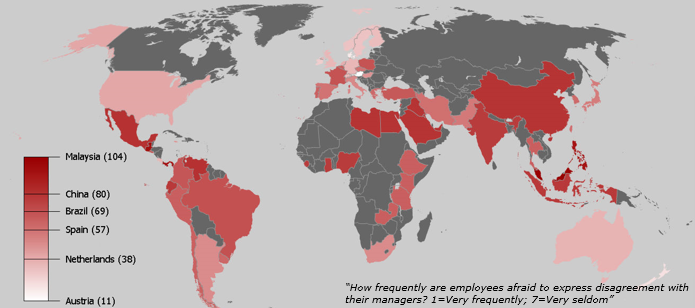
What is High vs. Low Power distance and some examples?
The degree to which less powerful members of a society accept and expect that power is distributed unequally
High power distance: accept a hierarchical order in which everybody has a place and this needs no further justification
Low power distance: people strive to equalize the distribution of power and demand justification for inequalities of power
PD correlates with income inequality (gap between rich/poor) and opportunity to rise in society
High PD = Asian countries
Low PD = Scandinavian countries, Austria
High power distance: accept a hierarchical order in which everybody has a place and this needs no further justification
Low power distance: people strive to equalize the distribution of power and demand justification for inequalities of power
PD correlates with income inequality (gap between rich/poor) and opportunity to rise in society
High PD = Asian countries
Low PD = Scandinavian countries, Austria
79
New cards
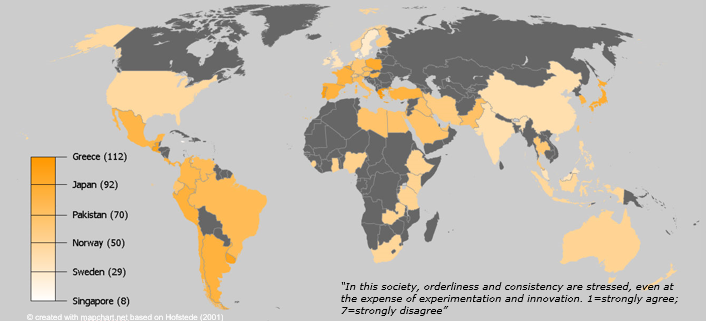
What is Uncertainty tolerance vs. avoidance and some examples?
Uncertainty avoidance: extent to which individuals within a society feel threatened by uncertain, unknown, ambiguous, or unstructured situations
Uncertainty tolerance: tolerance for ambiguity and no need for many formal rules
Power in lower UA cultures (high UT): take more risks, accept dissent (contradictory views over the same topic), let things happen
People in higher UA cultures (low UT): try to control future and plan everything, develop rules and rituals to cope with uncertainty, have clear scripts for interaction
Low UT (high UA) = Singapore
High UT (low UA) = Greece
Uncertainty tolerance: tolerance for ambiguity and no need for many formal rules
Power in lower UA cultures (high UT): take more risks, accept dissent (contradictory views over the same topic), let things happen
People in higher UA cultures (low UT): try to control future and plan everything, develop rules and rituals to cope with uncertainty, have clear scripts for interaction
Low UT (high UA) = Singapore
High UT (low UA) = Greece
80
New cards
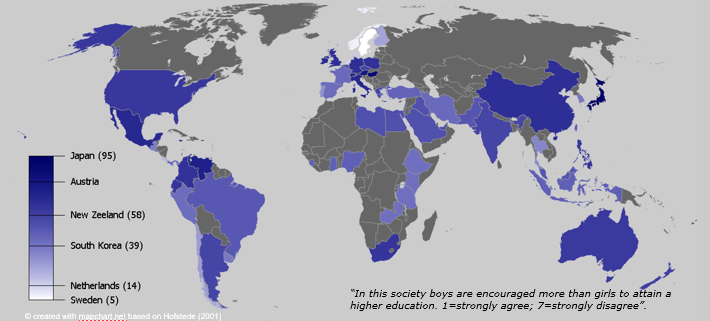
What is Masculinity vs. Femininity and some examples?
The extent to which social gender roles are distinct and emphasis is placed on feminine vs. masculine values
High masculinity = Japan
Low masculinity = Sweden
High masculinity = Japan
Low masculinity = Sweden
81
New cards
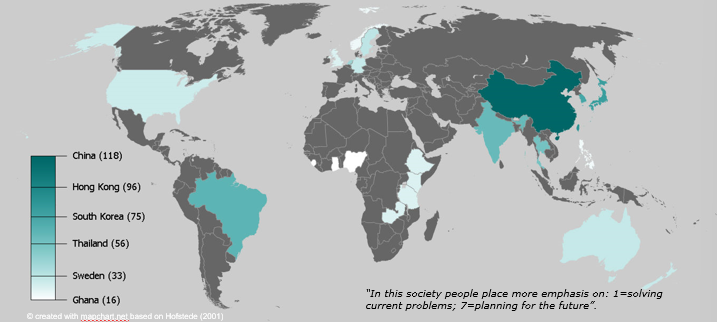
Long-term vs. Short-term orientation
Extent to which individuals direct their actions on future rewards vs. present (and past) rewards
Long-term orientation: encourages behaviors such as saving money, learning, relationship building, marriage, and child rearing
Short-term orientation: respect for tradition, preservation of "face," and personal steadiness and stability
Long-term orientation = China
Short-term orientation = Ghana
Long-term orientation: encourages behaviors such as saving money, learning, relationship building, marriage, and child rearing
Short-term orientation: respect for tradition, preservation of "face," and personal steadiness and stability
Long-term orientation = China
Short-term orientation = Ghana
82
New cards

Indulgence vs. Restraint orientation
Extent to which society allows free gratification of basic human drives related to enjoying life
Indulgence: allows relatively free gratification of basic and natural human drives related to enjoying life and having fun
Restraint: suppresses gratification of needs and regulates it by means of strict social norms
High indulgence = Nigeria
Low indulgence (restraint) = South Korea
Indulgence: allows relatively free gratification of basic and natural human drives related to enjoying life and having fun
Restraint: suppresses gratification of needs and regulates it by means of strict social norms
High indulgence = Nigeria
Low indulgence (restraint) = South Korea
83
New cards
According to the definitions in this book, which of the following would not be a good example of culture?
a. iPhones
b. Child learning how to tie her shoes from her mother
c. Child figures out how to create a hammer by tying a rock to the end of a stick
d. Child is given a new puzzle that she has never seen before, and she discovers a new solution by herself
e. Child learns to raise her hand in class to get teacher's attention
a. iPhones
b. Child learning how to tie her shoes from her mother
c. Child figures out how to create a hammer by tying a rock to the end of a stick
d. Child is given a new puzzle that she has never seen before, and she discovers a new solution by herself
e. Child learns to raise her hand in class to get teacher's attention
Correct answer: d
Culture is something that is learned! Answer D implies that there is no learning involved
Culture is something that is learned! Answer D implies that there is no learning involved
84
New cards
An important difference between cultural psychologists and general psychologists is:
a. General psychologists study people who have had their culture statistically controlled for
b. Cultural psychologists study people from different cultures, while general psychologists study people from one culture
c. Cultural psychologists believe the mind is interdependent with context and content whereas general psychologists believe the mind is independent from context and content
d. General psychologists believe people are born with essentially the same brain everywhere, whereas cultural psychologists believe people are born with different kinds of brains in different cultures
e. General psychologists believe experiences shape the mind, whereas cultural psychologists believe experiences do not shape the mind
a. General psychologists study people who have had their culture statistically controlled for
b. Cultural psychologists study people from different cultures, while general psychologists study people from one culture
c. Cultural psychologists believe the mind is interdependent with context and content whereas general psychologists believe the mind is independent from context and content
d. General psychologists believe people are born with essentially the same brain everywhere, whereas cultural psychologists believe people are born with different kinds of brains in different cultures
e. General psychologists believe experiences shape the mind, whereas cultural psychologists believe experiences do not shape the mind
Correct answer: c
85
New cards
A key belief of the Sambia is:
a. People are born gay and become straight with experience
b. There are no differences between women and men, so both women and men engage in warfare
c. The primary purpose of sexual activity is for pleasure, and they try to maximize the amount of pleasure for each person
d. Heterosexual intercourse and pregnancy are not related
e. Boys are born female and become male by acquiring semen
a. People are born gay and become straight with experience
b. There are no differences between women and men, so both women and men engage in warfare
c. The primary purpose of sexual activity is for pleasure, and they try to maximize the amount of pleasure for each person
d. Heterosexual intercourse and pregnancy are not related
e. Boys are born female and become male by acquiring semen
Correct answer: e
86
New cards
Imagine a psychological process that exists in all cultures, but is activated for different reasons across cultures. This would be evidence for a(n):
a. nonuniversal
b. existential universal
c. functional universal
d. accessibility universal
e. conditional universal
a. nonuniversal
b. existential universal
c. functional universal
d. accessibility universal
e. conditional universal
Correct answer: b
87
New cards
You review all the studies that you've done in your career and realize that they all use WEIRD samples. Based on this characteristic of your samples, which of the following challenges is the most applicable to your work?
a. determining universality
b. countering ethnocentrism
c. getting jerungdu
d. overcoming the Muller-Lyer illusion
e. defining culture
a. determining universality
b. countering ethnocentrism
c. getting jerungdu
d. overcoming the Muller-Lyer illusion
e. defining culture
Correct answer: a
88
New cards
While chatting over coffee with your friend, you overhear someone say, "I don't understand how those Hindus let cattle wander around their cities and not eat them. Where I come from, cattle are raised, branded, and then turned into steak and burgers. What the Hindus do just isn't normal." Which of the following does this situation best demonstrate?
a. segregation
b. ethnocentrism
c. integrationism
d. discrimination
e. assimilationism
a. segregation
b. ethnocentrism
c. integrationism
d. discrimination
e. assimilationism
Correct answer: b
89
New cards
When reference group effects occur in cross-cultural research, what's the reason?
a. People use social comparison to evaluate themselves
b. People don't really know how they feel
c. People from different cultures have different response styles
d. People value what they are most in need of
e. Some words do not translate well into other languages
a. People use social comparison to evaluate themselves
b. People don't really know how they feel
c. People from different cultures have different response styles
d. People value what they are most in need of
e. Some words do not translate well into other languages
Correct answer: a
90
New cards
What is a drawback to using back-translation?
a. The researcher might unintentionally prime participants to think in ways similar to English speakers
b. The literal meaning of the words is sometimes lost
c. The researcher has no way of identifying whether the translators faithfully captured the meaning
d. The translation may sound very unnatural, and may contain idioms that are unintelligible
e. Participants might not have good enough language skills to understand the materials
a. The researcher might unintentionally prime participants to think in ways similar to English speakers
b. The literal meaning of the words is sometimes lost
c. The researcher has no way of identifying whether the translators faithfully captured the meaning
d. The translation may sound very unnatural, and may contain idioms that are unintelligible
e. Participants might not have good enough language skills to understand the materials
Correct answer: b?? (come back to)
91
New cards
Which of the following is an advantage of experiments in cross-cultural psychological research?
a. The results can be generalized to more situations
b. They are easier to conduct than correlational studies
c. They are equally meaningful to people in all cultures
d. They make response biases less problematic
e. They can more easily be conducted in the real world
a. The results can be generalized to more situations
b. They are easier to conduct than correlational studies
c. They are equally meaningful to people in all cultures
d. They make response biases less problematic
e. They can more easily be conducted in the real world
Correct answer: d
92
New cards
The tendency for people living in conditions with a real threat of starvation to value food more than those living where food is abundant is an example of:
a. the reference group effect
b. socially desirable responding
c. acquiescence bias
d. unsynchronized sample selections
e. the deprivation effect
a. the reference group effect
b. socially desirable responding
c. acquiescence bias
d. unsynchronized sample selections
e. the deprivation effect
Correct answer: e
93
New cards
After examining surveys you collected from culture X, you find that people's responses tend to cluster toward the center of your scale. This phenomenon is known as the
_______ bias:
a. acquiescence
b. social desirability
c. moderacy
d. deprivation
e. extremity
_______ bias:
a. acquiescence
b. social desirability
c. moderacy
d. deprivation
e. extremity
Correct answer: c
94
New cards
According to a culture of honor explanation, the U.S. South has historically been more violent than the North because:
a. the South is hotter than the North
b. there was a more extensive slave trade in the South than the North
c. the South is poorer than the North
d. there were more herders in the South than in the North
e. there are more guns available in the South than in the North
a. the South is hotter than the North
b. there was a more extensive slave trade in the South than the North
c. the South is poorer than the North
d. there were more herders in the South than in the North
e. there are more guns available in the South than in the North
Correct answer: d
95
New cards
Your research team found evidence that people in multiple cultures walk with their shoes on their heads; but this “shoe-on-head” way of walking is activated for different reasons across cultures. This would be evidence of a(n)…
a. non-universal
b. existential universal
c. functional universal
d. accessibility universal
a. non-universal
b. existential universal
c. functional universal
d. accessibility universal
Correct answer: b